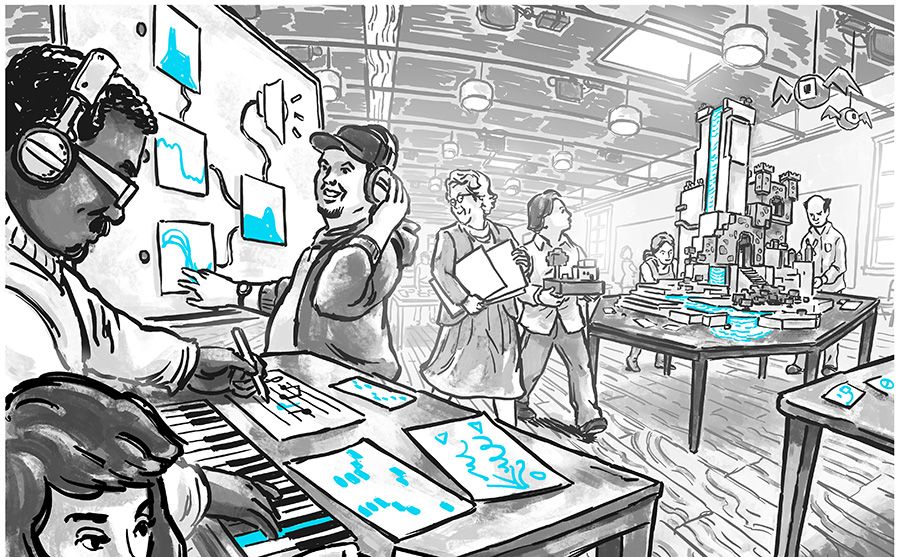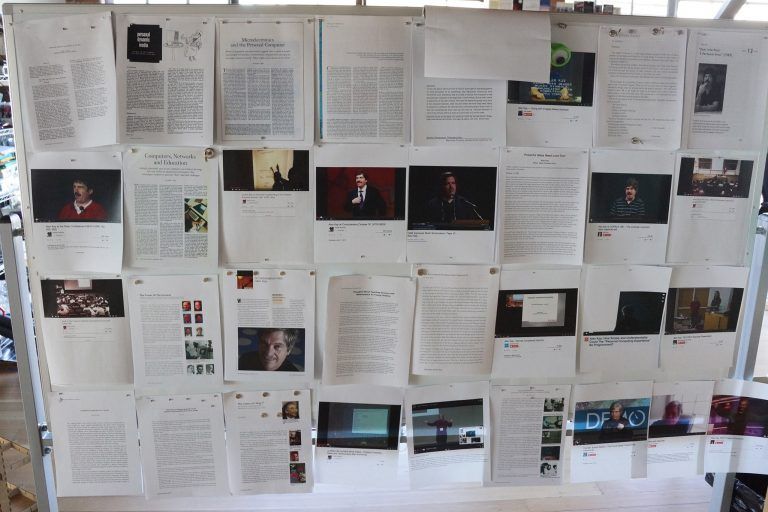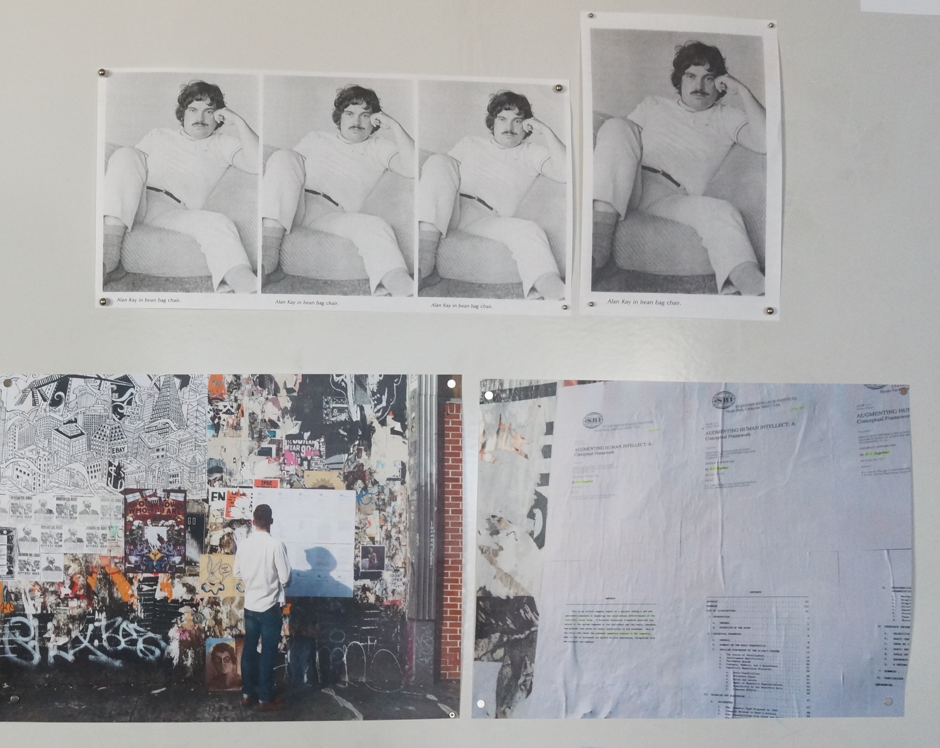Limn: Utopian Hacker
Compiled from: Utopian Hacks - Limn by Götz Bachmann
In an Oakland lab, an elite group of unorthodox engineers is trying to reimagine what computers can and should do. It is here, in this lab in Silicon Valley (or close to it, depending on how you draw its boundaries), that my ongoing ethnography is based on. The team, gathered around an engineer named Bret Victor, is part of YC Research Center's Human Advancement Research Community (HARC), an industry-funded research lab dedicated to open and fundamental research . "Hacking" refers to members of this group, like many other engineers, and is at best a word used for tentative work (eg: "This is just a hack"), or the use of technology for other purposes, while Not the original purpose. It can also be a pejorative term referring to the cumulative consequences of amateur, low-quality technical development without taking into account. So: when the engineers I study describe their work, "hacking" isn't going to be one of the key terms they'll choose. However, I would say that some of their work practices have similarities to hacking, albeit in a different area. This post asks: How do engineers crack what imaginary technology is and can be?
I make this point by analyzing these engineers, which I call "radical engineering" for no better term. Radical engineers fundamentally challenge existing concepts of technology (in this case, digital media): their basic characteristics, purpose, and possible future. Their radicality is not to be confused with political radicalism, "subversive" radicality, or the radicality of certain engineering results. Their radicality places them outside the broader engineering fields that are obvious, self-evident, time-tested, or desirable. Their positions are so heretical that they often stop calling themselves "engineers." But no other word can replace it. They might try to use terms like "artist" or "designer the Horst Ritter way," but both are unstable and misleading. After all, these people are educated in subjects such as electrical engineering, mechanical engineering, computer science or mathematics, and their jobs often involve solving highly complex technical problems.
Bret Victor's team tried to build a new medium. Achieving this is not so much a matter of sudden flashbacks as it is a permanent, stubborn process beyond what is currently conceivable. The lab takes existing technologies, such as projectors, cameras, lasers, whiteboards, computers, and Go pieces, and combines them with new or historic ideas about programming paradigms, system design, and information design, as well as a range of Knowledge, communication, social, political and media assumptions and visions are restructured. The team is building a series of operating systems for a spatially dynamic medium, each based on the building experience of the previous operating system, and each operating system will take about two years to build. The current operating system is named "Realtalk", and its predecessor was called "Hypercard in The World" (both names pay homage to historical, unorthodox programming environments: Smalltalk in the 1970s and 1980s Hypercard). When this team develops such an operating system, it involves the process of writing and rewriting code, as well as manifestos, lots of talk, and even more moments of collective silence, mantras of iteration and adjustment, digesting movies and books, and lots of technical papers, and build dozens — literally hundreds — of hardware and software prototypes.
The lab is full of prototypes, with new ones being added every week. Within a month, a visitor could point a laser at a book in the library and a projector would project the book's interior onto the wall next to her. In a few weeks, you'll see people jumping around on the floor playing a game of "laser socks": people trying to laser light each other's white socks. A few months later, a table was turned into a pinball machine made of light from a projector, and a video of the cat followed around each rectangle drawn on the paper. Currently, the group is experimenting with "little languages" in the medium of space: domain-specific programming languages based on paper, pen, scissors, chess pieces, or lines, all with dynamic properties and thus the ability to directly guide computation or visualize complexity. The point of all these prototypes is not that dazzling technical sophistication. In fact, it's quite the opposite. The purpose of a prototype is simplicity and simplicity - as a rule of thumb, you can assume that the fewer lines of code involved, and the simpler those lines are, the more successful the prototype is considered to be.

Intriguing as these archetypes are, they are still "working artefacts" that use "illusions of self-movement" to form "traps" for potential possibilities. In Bret Victor's research group, prototypes work to capture and demonstrate the underlying properties of a new, spatial and dynamic medium. Since one of its desirable properties is simplicity, those archetypes that display this property are often chosen as successful. Every two years or so, the entire process yields a new OS, which then allows for the construction of a whole new generation of prototypes, often (though not always) based on the capabilities of the respective current OS, while already exploring the next generation. Potential. The overall goal is to create a fundamental breakthrough, a technological leap equivalent to the 1960s and early 1970s, when the quadruple introduction of microprocessors, personal computers, graphical user interfaces and the Internet, by turning computers into A medium that revolutionized computing. Turning computing into a medium already meant fighting technology against technology in the 1960s and 1970s: through the use of new computing power, a medium was created that did not quite fit the perception of what a computer was at the time, And more in line with what a medium might look like to form a dynamic version of paper. In the work of Bret Victor's research group, this form of work against computing has become radical.
The patron saint of this cause, both in spirit and in real life, is Alan Kay, one of the most famous radical engineers and a key contributor to those breakthroughs in computing in the 1960s and 1970s , Bret Victor's team is trying to catch up on these breakthroughs today. Let's get to know Alan Kay. In the 1960s, he started working in the newly formed computer science department at the University of Utah, writing what is arguably one of the most daring doctoral dissertations ever written, a wild technical dream about a new type of computing. The paper begins with a cry of desperation from another radical engineer—"I want these calculations to be done with steam" (by Charles Babbage)—in working on the "reactive engine" After 250 pages of reflection, the paper culminates in a fictitious "Flex Machine" handbook: the first iteration of a series of ideas, a few years later visions in Alan Kay's "DynaBook" (1972) reached its peak. While working on the paper, Kay was one of the young men in a research community funded by the Pentagon's Advanced Research Projects Agency's (ARPA) Information Processing Technology Office (IPTO), which was working toward building the ARPANET. )take the first step. In the early 1970s, after a stint as a postdoc with John McCarthy at Stanford University, Kay joined Bob Taylor's new Xerox PARC research lab, where the engineering community Legends like Lampson, Thacker, Metcalfe, and many others, are building the ALTO system, the first system to connect separate machines with advanced graphics capabilities.
Once the first iterations of the ALTO/Ethernet system - it is crucial to understand that the latter is a system rather than a stand-alone computer - were up and running, they provided Alan Kay with a powerful playground. Alan Kay looks back on some of his work in the 1960s, when he analyzed SIMULA (an obscure Norwegian programming language) and, with Dan Ingalls and Adele Goldberg, among others, developed an A hybrid between programming languages, operating systems and children's toys - Smalltalk. The first iteration of Smalltalk was an object-oriented experiment to model all programming from scratch after a distributed message-passing system: later versions dropped this, and after an initial phase of success, Smalltalk eventually lost to Languages such as C++ and Java lost their object-oriented dominance. But in the mid-1970s, the ALTO/Ethernet/Smalltalk system became a breeding ground for an explosion of ideas about the Graphical User Interface (GUI) and many now-common applications. As such, the work of Kay and his "Learning Research Group" can be seen both as a lost holy grail of computing, undermined by the computing model capitalism forged in hardware and software, and as the key to its subsequent emergence One of the genealogy centers. And it is this double meaning that makes this work so unique and interesting to this day.

Alan Kay's contribution to the history of computing was the result of a radical reversal of the computing paradigm and imagination of his time. Kay employs unorthodox programming techniques like those pioneered by SIMULA, new visualization techniques like those developed by the Sutherland brothers, McCarthy's desire for "private computing" and Wes Clark's "lonely machines", Doug Enhanced experiments by Doug Engelbart's group, new ideas for distributed networks, and more. This technique is uncommon in the emerging software engineering and programming professions, but has begun to circulate among the elite engineering circles where Alan Kay works. Alan Kay Connects Them with Maria Montessori, Seymour Papert, and Jerome Bruner on Pedagogy, Psychology The ideas of science and mathematics are combined and further added to the dynamism by Marshall McLuhan's funky media theory speculation. Kay also understood early on the meaning of what Carver Mead called "Moore's Law," a rule of thumb triggered by mass-produced integrated circuits that keep getting smaller, faster, and faster. The exponential line, a cheap form of calculation, now leads to a positive feedback of technological development and the creation of new markets. So Alan Kay put all these ideas, aspirations, techniques and opportunities back together. The result is an important contribution to the technological imagination of a new and emerging society, representing in many ways the computer as a digital medium that we have today. As such, Alan Kay's work can be considered a benchmark for radical engineering, as it allows us to critique the deadlock and possible degradation of most current imaginations about technology.
But is it really that easy? Is radical engineering just the result of a little mixing? Obviously, this is a more complicated process. One of the most telling descriptions of this process comes from another legendary radical engineer, the aforementioned Doug Engelbart. In 1962, a few years before Alan Kay began his career, Engelbart developed the project for his own U.S. Air Force-funded research group at the Stanford Research Institute to redesign the "HLAM-T" , namely "Human using Language, Artifacts, Methodology, in which he is Trained". The HLAM-T has always been a cyborg, so it can participate in an ongoing process of "augmenting human intellect." According to Engelbart, the latter can be achieved through a process of "bootstrapping". In Silicon Valley, the term can mean many things, from launching systems to launching startups, but in the context of Engelbart's work, "bootstrapping" is "...the interesting (recursive) task of developing tools and technology to accomplish tasks more efficiently. Its tangible product is an augmentation system under development that provides enhanced capabilities for the development and research of augmentation systems” (…interesting [recursive] assignment of developing tools and techniques to make it more effective at carrying out its assignment. Its tangible product is a developing augmentation system to provide increased capability for developing and studying augmentation systems). It's a dream of exponential progress emerging from nonlinear, self-enforcing feedback, as Moore's called it. Can you be more Californian?
In order for Engelbart and English's description to be more than a cybernetic pipe dream, we need to remind ourselves that they are not just talking about technological artifacts. Simply building prototypes out of prototypes is not a smart move for radical engineering: prototypes tend to break down once put into use; therefore, the prototype toolset is not very useful for developing further prototypes. Therefore, "bootstrapping" as a process only works if we assume it is a larger process in which "tools and techniques" are developed over a longer period of time with social structures and local knowledge Yes, the bootstrapping method can work. The process is recursive, much like what Chris Kelty describes as the "recursive publics" of the free software development community: in both cases, developers create socio-technical infrastructure through which they can communicate and collaboration, which then spreads to other parts of life. Kelty shows that this recursive effect is not just the magical result of self-reinforcing positive feedback. The recursive process is based on politics, resources, qualified people, care and guidance. In short, they need to be constantly produced.
Therefore, bootstrapping can take different extents and orientations. Although Engelbart and English's project sounded ambitious, at least in the 1960s, they believed that bootstrapping within a research group would have the desired effect. Alan Kay's Learning Research Group expanded on this setting in the 1970s through pedagogy and McLuhan's media theory. By introducing children, they aim to achieve recursive effects beyond the laboratory, with the long-term goal of engaging the whole world in a bootstrapping-like process. Bret Victor and his research group's bootstrapping is like a multi-layered onion. What kind of people should be a part of it, and when, can lead to heated internal discussions. Once the group rolls out "Dynamic Land," it will move to the next phase. Meanwhile, bootstrapping has taken many forms. Prototyping involves the process of bootstrapping, such as pointers, tentacles, searches, riffs, scaffolding, operating systems, blocking, performance, imagined test cases, demos, and more. In fact, a lot of prototyping techniques are involved in the larger bootstrapping process. In the lab, together, they created a feeling of sitting in the brain. The laboratory as a whole—its walls, tables, whiteboards, roof, machines, and the people who live in it—serves as the first demonstration of an alternative medium.

Building iterations of an operating system family can require significant engineering tasks in the more traditional sense; such as writing a kernel in C, or a process host in Haskell. But the overall effort is clearly not driven by technology. In the future medium of space, computing should decrease. Computing will play the role of infrastructure: just as books need light, but instead of imitating the logic of light, the medium can take advantage of the computational possibilities offered by the back-end operating system when necessary, but it should not be driven by them. On the contrary, dynamic space media should be driven by the characteristics of the medium itself, and should also be driven by technology. The properties of this medium are yet to be explored in the bootstrapping process. In the group's words, both the medium and the way they produce it are "from the future". This future is not given, but depends on the medium the group is imagining. Therefore, it depends on the properties of the medium that the group is exploring, choosing and practicing. On the one hand, technology has given birth to a new medium that is imagined to shape the future, and on the other hand, the future is imagined to shape the new medium, which in turn is supposed to drive technology.
While much of the group's work is building equipment, thinking is also part of their job. The latter enables engineers to understand what the prototype work reveals. It also gave directions to the lab, inspired its career, and was part of the funding. So far, the whole process has resulted in a series of interrelated and evolving ideas and goals: for example, one group is finding new ways to represent and understand complex systems. The second group aims to generate incomprehensible forms of knowledge, such as trillions of lines of code, written on the screen by unblocking the constraints of contemporary media such as the screen, through "hide-and-seek" access to complex things , then stare at the screen) to gain more knowledge. The third group explored new forms of expressing time, and the fourth group explored new forms of incorporating physical properties more effectively into spatial media systems. All these clusters lead, so goals and assumptions move up and down the "ladder of abstraction" more seamlessly. Seemingly to echo the media-theoretical thinking of Nietzsche, McLuhan, or Kittler with engineering solutions, a larger goal was to enable new ideas that, due to the deficiencies of contemporary media, have remained is "unthinkable". Enhanced forms of embodied cognition, and better ways of cooperating to generate ideas, can heal the loneliness and suffering that are often part of deep thinking. All of this together could "stop the world from dividing," citing an internal email.
One way to understand what's going on here is to frame all of this as another form of "hacking". When you "hack" you can say hacking apart or hacking together. Hacking apart can be seen as a practice developed from the refusal to accept previous black box behavior. Moving to the realm of radical engineering, hacking apart means not accepting the black boxes of current technological paradigms, like screen-based computers, or off-the-shelf futures, like "smart cities, smart homes," or "Internet of Things." Instead, you open up such black boxes and dissect them: assumptions about what counts as technological success and about future technological progress, matching some version of the social order and often combined with unhealthy business opportunities porn . The black box will likely also contain ideas for different types of roles such as engineer, programmer, designer, manager, etc. If you take this all apart, you might look at the elements, throw away a lot of them, distort others, add some from elsewhere, and grow some of your own. You'll study different, often historic, technological paradigms, as well as other ideas about what's technically possible (and when), different ideas about social order, the good life, and problems that need to be solved, reading for Other books, different uses of the power of the medium, and different perspectives on what kind of people and their professional or non-professional nature, and who should be responsible for it all. If you're lucky, you have the conditions and ability to do it all in a long, non-linear process, also known as bootstrapping, where you go through multiple iterations of hacking apart and hacking together, Simultaneously creating fundamentally different ideas about what technology should and can do, and helping shape those ideas through a range of means and practices, and "demonstrating" to myself and others that some utopia may not be out of reach. That's what radical engineers do.
While they have made considerable efforts to escape the illusion of technological solutions, they have not abandoned the engineering approach to solving problems by building things, they have developed an approach that one might call "radical media" solutionism” (radical media solutionism), although they also have an ambivalent attitude towards the latter. To avoid misunderstanding: Neither the engineers I study nor I think the real future can be cobbled together by a group of engineers in Palo Alto or Oakland alone. But I do think that radical engineers like Engelbart, Kay, or Victor's research groups, in their specific, highly privileged positions, add something crucial to the complex mix of forces driving us into the future. The fieldwork I'm doing has made me curious about what's being produced here, and many who visited the lab agreed that the first "arrivals" were truly astounding and incredible. If we believe this organization's self-perception, then their technology is like a hacker, providing a temporary solution to something bigger that may someday come. Radical engineers will also be the first to come up with the same temporary solutions, which are a potential source of hackers in a derogatory sense if they stop development and materialize prematurely. The latter, according to their story, is exactly what happened 40 years ago, when prototypes left the lab prematurely and entered the world of Apple, IBM, and Microsoft, resulting in a deluge of bad decisions that people now stare at smart phone.
In such a story, the radical engineer may take a retrospective "could have" approach, mixed with traces of distinction from "normal" engineers. Even if they are far from the startup culture of Silicon Valley, their isolation from the "California ideology" may not always be 100% tight. In fact, they may provide a much-needed heresy solution to the Silicon Valley mainstream. These radical engineers, however, are potential allies of those who aim to break the libertarian, totalitarian, and powerless fantasies that Silicon Valley often offers us, whether it's the "Internet of shit" or the "Internet of Junk." From a critical theory perspective, from a social movement perspective, or through analysis of political economy, the conceptual poverty of the future currently available to most of Silicon Valley can certainly become visible. But if we compare Silicon Valley to the utopia of radical engineering, it also becomes evident in its intellectual timidity, which is only overshadowed by the havoc it causes.

About the author: Götz Bachmann is Professor of Digital Culture and Convenor of the Bachelor of Digital Media at the Institute of Digital Media Culture and Aesthetics at the University of Leuphana, Germany. He is also currently a visiting scholar at Stanford University. He is an ethnographer who has conducted fieldwork among warehouse workers, salespersons and cashiers in Germany and Nico Chuu in Japan. He also wrote the German children's comic series KNAX.
Like my work? Don't forget to support and clap, let me know that you are with me on the road of creation. Keep this enthusiasm together!




